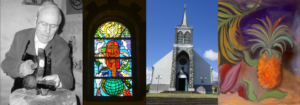FOCUS : CHARLES CARRÈRE THE SURREALIST ARTIST
2024: Surrealism celebrates its 100th birthday!
Surrealism is a poetic and artistic movement that had its origins in the Dada movement. It was a total questioning of conventions and constraints, whether ideological or aesthetic.
For Charles Carrère, surrealism is like a second skin. He likes to distort reality, he deviates from classical representation to create new approaches where censorship can no longer exist. Anything goes.
Charles Carrère explained surrealism as a liberation from the control of reason, with the free expression of dreams.
He illustrated his definition with this pen-and-ink work that he simply called “Self-portrait”, and when I asked him for an explanation he replied “That’s all there is in my head”.

The artist wasn’t very talkative and disserting at length on a subject seemed to him to be a waste of time. Nevertheless, I was given the privilege of a detailed explanation so that I could testify to his work during my lectures.
Moreover, he referred any attempt at further questioning to the reading of the surrealist manifesto written by André Breton.
Charles Carrère preferred to show his drawings and paintings and observe the reactions rather than talk about his work.
He produced a considerable number of drawings, collages, watercolours and oils, but kept them jealously guarded. Every day, once his day as a master glassmaker was over, he would go upstairs to his world and join his studio as a draughtsman and painter.


The artworks illustrating this Focus :
1. Iris noir in deep mourning

Charles Carrère gave her black iris a look, creating the illusion of a face. He has also fitted it with a mantilla to give a certain nobility to its mourning flower attitude.
The artist relied both on graphic humour, with the visual gag that we see at first glance, and on the black humour in which he excelled: this flowery symbol of hope or the mythological memory of the goddess Iris who brought only good news… It was his way of exorcising old sufferings following remarks in which people described the works he was proud of as strange and abnormal….
In fact, surrealism was part and parcel of him from the moment he took on his role as a draughtsman and painter.
2. Banania extraction (Banania mining)

“L’extraction du Banania” a surrealist work by Charles Carrère, is a watercolour gouache dating from 1972. The artist indulged in the “gourmet dream” of a giant banana from which the juice is extracted, then transported on a conveyor belt and in wagons – a bit like coal to the processing plants – and finally cooked in the furnace that can be seen in the background.
3. A bird in a feather

pour l’Association Charles Carrère
This is in fact a detail from a work entitled “Chien Chat Oiseau” (Dog, Cat, Bird) created using watercolour gouache for the background and collage techniques for the animals which are reconstituted using elements cut out from magazines.
For the bird, Charles Carrère started by creating its profile in gouache and then pasted a feather cut out from a magazine.
It was the ‘Bird with minimum trim’ aspect that really amused the artist.
Here is the painting from which the bird is taken: For the dog, the artist cut out faces and photos of humans: you can see this easily with the eyes, but he separated the different parts and ‘sowed’ them on the dog. The detail on the 2nd paw reveals a human finger instead of a claw, and on the hind paw just before the tail you can see an arm with a gold bracelet on the wrist (click on the image to see this detail). The black cat is made from black hair cut from a hairdressing magazine.

Gouache and collage ©CharlesCarrère Photo©Janie C / Association Charles Carrère

Artworks by Charles Carrère
* “L’enterrement du centaure” – pen drawing + watercolour gouache + oil

Photo©Janie C pour l’Association Charles Carrère
With L’enterrement du centaure, Charles Carrère offers us a fine palette of anthropomorphic creatures.
The artist sets the scene on the shores of the Aegean Sea, on a beach with huts and centaurs. We find ourselves plunged into mythology in the middle of south-eastern Thessaly, in the valleys of Mount Pelion, populated by centaurs.
But Charles Carrère has imagined an independant scenario of Greek history. He explains that it is the friend of the deceased, a centaur like himself, who pulls the hearse; it will be noted that he is very sad.
In the foreground, two insect-like figures with bird’s feet are tasked with restoring the balance of the vehicle, if necessary, using the rope connected to the canopy on which a bird stands. But in fact, these insects are there as a somewhat curious audience.
At the back of the hearse is a procession reduced to two praying mantises held between two fringed ropes by a sort of miller in a black and white checkered blouse. Behind him, wearing a sort of Second Empire cocked hat, we see a sub-prefect or an official “Who gives himself important airs”, as Charles Carrère liked to say.
In the distance, by the sea, the ghostly silhouettes of centaurs seem to pay homage to their fellow human beings. An open-winged bird stands in front of them, could it be the security cordon? ….
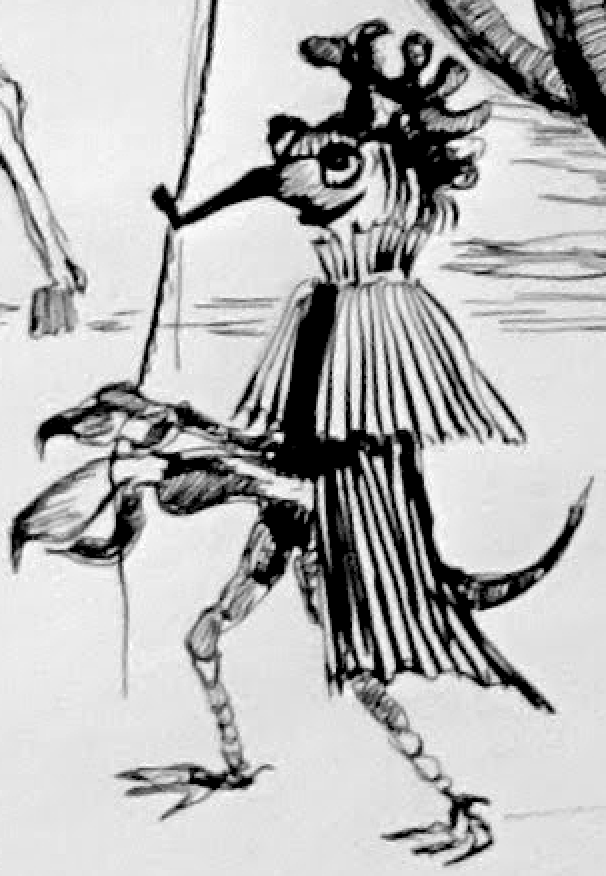


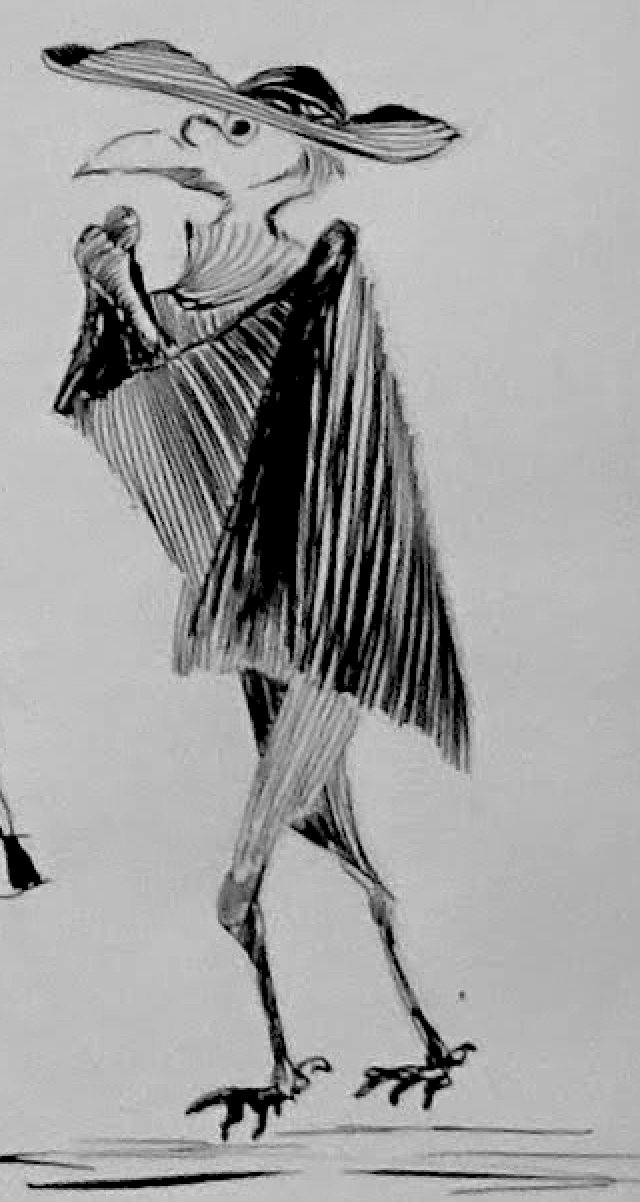
The artist’s favourite creatures were the praying mantises that follow the convoy. They can be seen again in the watercolour gouache below, but in a slightly modified form, as here they are linked to the hearse by a rosary.
Charles Carrère said that he preferred the centaur in this gouache because its face expressed more sadness. To see it, just click on the image. As for the praying mantises, when I zoomed in with my camera and showed Charles Carrère the result, we laughed heartily. He even asked me to take a photo of the two praying mantises in the watercolour gouache.

Photo©Janie C pour l’Association Charles Carrère

Another version of the burial of the Centaur is this one. It is painted in oil on canvas. And here we see that there are many more people in the procession following the hearse.
And this time it’s a donkey pulled by a human! The centaur friend of the deceased is right behind the cortege. Just in front of him, in the foreground, we also see a kind of bird wearing a red skullcap and the “Cappa magna”, the cardinal’s ceremonial habit. The Cappa Magna is held by another bird in the cardinal’s service.
In front of and on either side of the cardinal, two onlookers follow the convoy. And at the cardinal’s level, but on the beach side, we find the official with his great air, as Charles Carrère reminds us.

Birds play a major role in Charles Carrère’s work. They play an important role in his life. In his youth, he lived on the Angloy family farm near Butte aux Cailles. As a child, he watched with horror and fascination as women plucked birds.
He never stopped wanting to bring them to life. He depicted them in anthropomorphic form, sometimes taking the opportunity to denounce human failings.
* “MAYFLOWER”
NEW USE FOR A GRAVY BOAT 1/4
During his many “drawing research sessions”, when he had chosen his grandmother’s gravy boat to do a still life in charcoal, Charles Carrère’s imagination transformed it into a ship…

Photo©Janie C pour l’Association Charles Carrère

This is how the gravy boat became the Mayflower, the ship that marked the history of the colonisation of the United States. The Mayflower carried Protestant dissidents who had been persecuted in England and who wanted to find a suitable place to practise their religion.
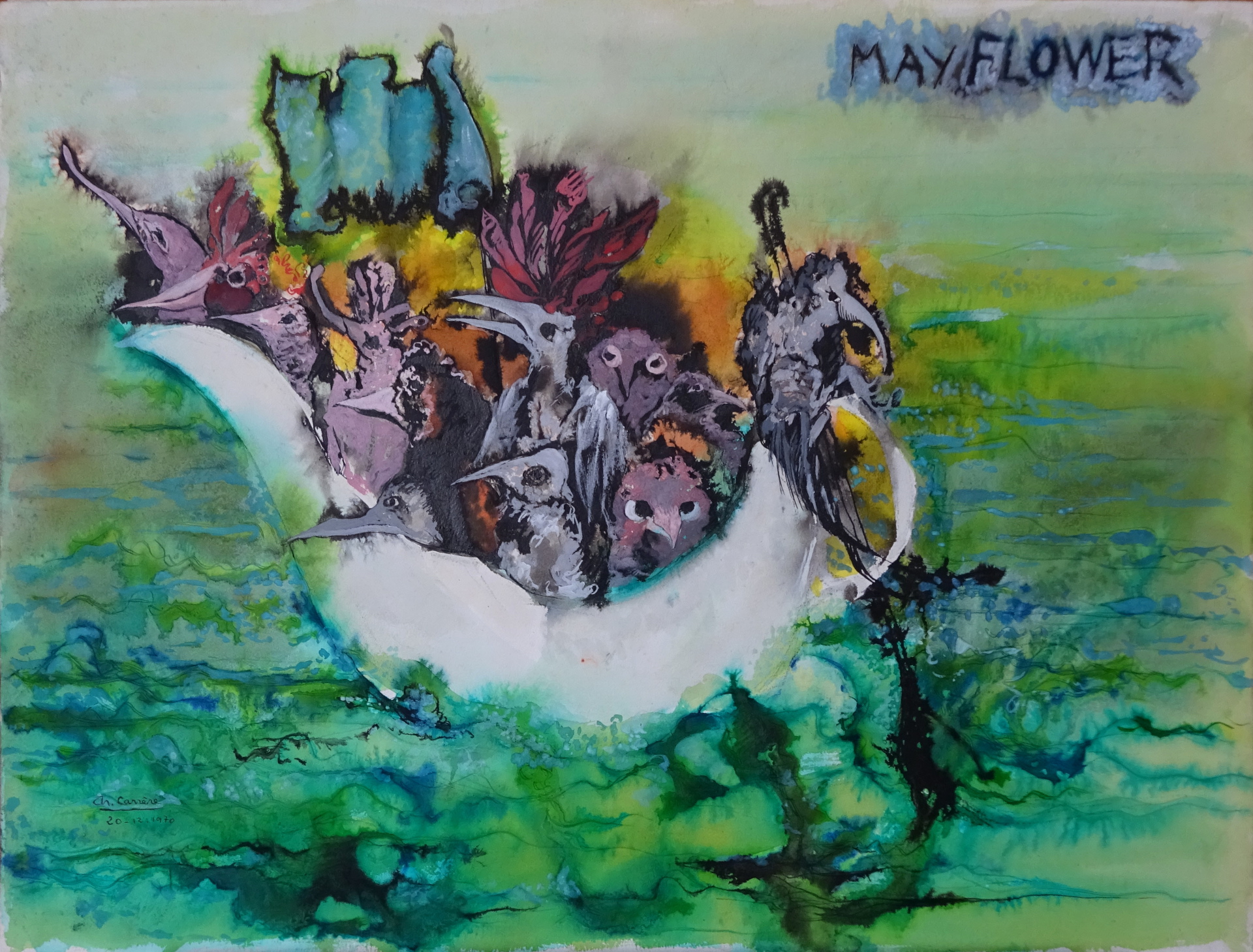
Photo©Janie C pour l’Association Charles Carrère
* “SETTING SAIL FOR THE AMERICAS FROM LA BARRE IN THE 19TH CENTURY “
NEW USE FOR A GRAVY BOAT 2/4
This same sauceboat would inspire the artist several times, as it appears in a charcoal caprice.
The idea came to him after reading an article on Basque emigration to America in the 19th century. Charles Carrère was astonished to learn that 100,000 Basques left the country to try their luck on the other side of the ocean.
The artist lives in Anglet and likes to go for walks near La Barre, where the Adour flows into the ocean.
His imagination led him to create a wooden pontoon on which the worried family is standing as they say goodbye. And the saucer-ship accentuates the fragility of the boat in the face of the strength and immensity of the ocean….
A charcoal work was created entitled “Partance pour les Amériques à La Barre au dix-neuvième siècle” (“Setting sail for the Americas at La Barre in the nineteenth century”).

photo©Janie C pour Association Charles Carrère
* “THE SHIP OF FOOLS”
NEW USE FOR A GRAVY BOAT 3/4
Charles Carrère then offered an oil on canvas, again featuring his grandmother’s sauceboat.
His work, entitled “La nef des fous” (“The Ship of Fools”), was inspired by an engraving “L’écaille naviguant” de Pieter van der Heyden inspired by Hieronymus Bosch. Van der Heyden’s work shows madmen and madwomen sailing in a giant half-open mussel.
The third reference has to do with the title, it’s literary, it’s a book entitled “La Nef des fous” of Sébastien Brant about the human condition. The author knows that the boat is simply sinking.
If you look closely at this work by Charles Carrère, you can see a clear similarity with the characters on the Mayflower. But here the birds are even more numerous, and that’s what defines this nave of fools – it’s a crazy idea to imagine that this saucer full to bursting is going to attempt the ocean crossing!

Photo©Janie C pour l’Association Charles Carrère
* “DANTE AND VIRGIL”
NEW USE FOR A GRAVY BOAT 4/4
And to show that his grandmother’s gravy boat is definitely a great source of inspiration, here’s a charcoal caprice entitled “Dante and Virgil”, taken from “The Divine Comedy”.
In this poem written by Dante, we discover his journey to hell, guided by Virgil. He will cross the three super-terrestrial kingdoms, which will lead him to the vision of the Trinity.
But the idea for the boat was inspired by the work of Delacroix “La Barque de Dante” in the Musée du Louvre in Paris. Eugène Delacroix’s work illustrates the fifth circle of Hell, that of the angry condemned to dwell in the muddy waters of the Styx. In Charles Carrère’s work, the angry are embodied by the birds seen gallivanting around the gravy boat.
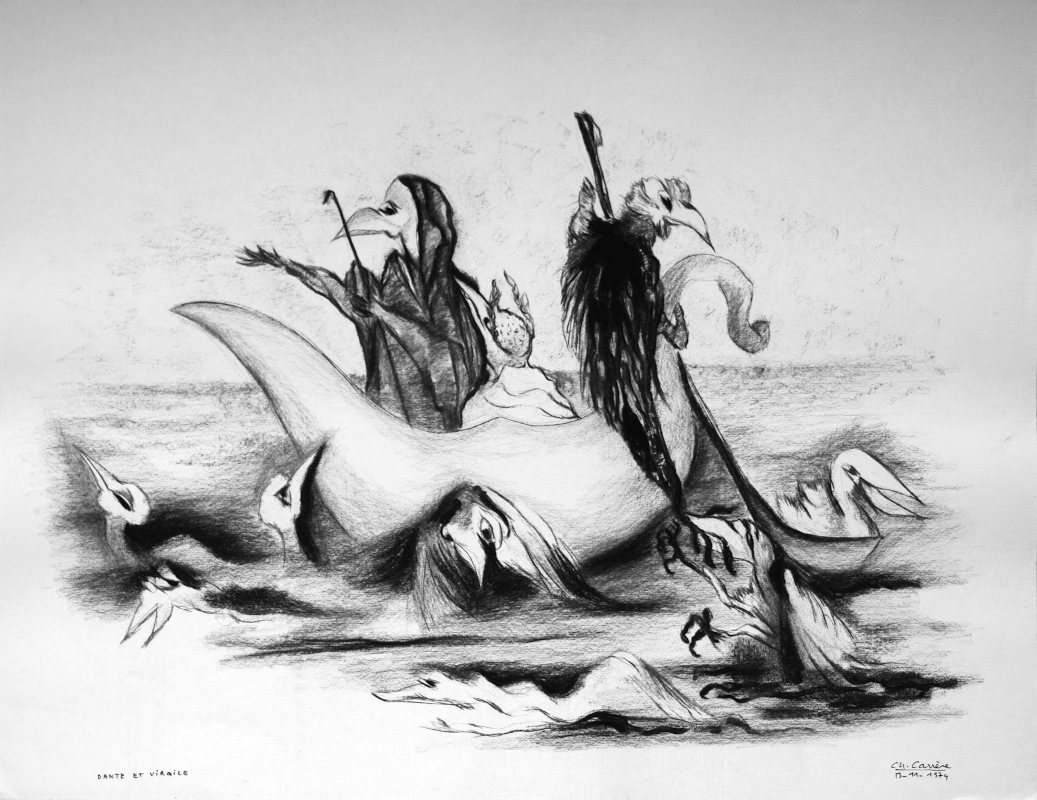
Photo©Janie C pour l’Association Charles Carrère
Clearly, there are still many surrealist works by Charles Carrère, and as they are produced using different techniques – charcoal, ink, pen, watercolour gouache, oil, collage, etc. – you will be able to discover more during the next Focus on his work as an artist.
Nevertheless, here are a few works and for the pleasure of discovery, you can click on each photo:


Photo©JanieCailliau







Inspiring Artists
Charles Carrère’s passion for the funny things of the Middle Ages and the drawings found in the margins of manuscripts naturally fired his fertile imagination.
But for him, the “star” precursor of surrealism is Hieronymus Bosch. “That’s my feeling,” he defended himself. Charles Carrère was in “perpetual exercise” as if in “drawing training” in the same way as a sportsman. He liked to create works inspired by his favourite artists, as here with “The Temptation of Saint Anthony”, a work by Jérôme Bosch that is kept at the National Museum of Ancient Art, Lisbon (MNAA).
Charles Carrère has taken the figure with the funnel on his head, who seems to be carrying a message, from the work of Jérôme Bosch, perched on his ice skates (left panel, bottom right), but Charles Carrère has placed him on the right of his charcoal drawing and represented him as a walker carrying a stick. As for the fish-vehicle (bottom centre panel), Charles Carrère placed it to the left of his “caprice” and drew a figure astride the fish. “The vehicle is driven using a lure, a reference to the carrot used to drive a donkey.

by Charles Carrère
photo©Janie C pour Association Charles Carrère



Charles Carrère had a particular affection for the contemporary Belgian surrealists René Magritte and Paul Delvaux. He would have liked to visit the René Magritte museum in Brussels and the Paul Delvaux museum in Sint Idesbald.
Here are just a few names from the long list of artists who left their mark on him and inspired him to pursue his artistic research throughout his life: Goya and his visionary genius, Pieter Brueghel the Elder and his surrealism in “Margot the Mad”, Albrecht Dürer and his surrealist vision in “Nemesis”, Pablo Picasso for the discovery of collages and then his cubist and surrealist work – Max Ernst with his surrealist paintings and sculptures, his scratching, etc. – and many others. – Salvador Dali and his immense body of work, which has taken him as far as cartoons, advertising and fashion, and which caused a scandal with his declaration that “I am the surrealist”, and many other artists, of course, whom we will be discovering in future Focus.
This post is also available in: French


